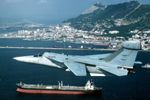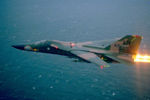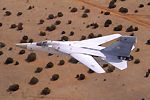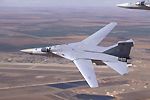
original at www.af.mil |
EF-111A
(USAF Photo)
A United States Air Force EF-111A Raven prepares to taxi out at dusk. The Raven is an electronic countermeasures aircraft capable of cruising at more than Mach 2.2. |

original at www.af.mil |
EF-111A Ravens Patrol The Skies Over Southern Iraq
(U.S. Air Force Photo by Staff Sgt. Angela Stafford)
Crewmembers from the 27th Fighter Wing, Cannon Air Force Base, N.M.,prepare to launch one of their EF-111A Ravens at Dhahran Air Base, Saudi Arabia.The 13th is one of many U.S. and coalition units supporting Operation SouthernWatch, which enforces the United Nations-sanctioned no-fly zone below the 32ndparallel in Iraq. These units are involved in another operation while continuingto enforce the no-fly zone, Operation Desert Focus, the movement of U.S.aircraft personnel to Prince Sultan Air Base, Saudi Arabia. The move's purposeis force protection, and comes in the wake of the June 25th terrorist bombing atKhobar Towers which killed 19 airman and wounded many more. |

original at www.af.mil |
An EF-111A flies off the Rock of Gibralter
(U.S. Air Force photo by Master Sgt. Dave Nolan)
An EF-111A flies off the Rock of Gibralter. Ravens will no longer be in the Air Force inventory from May 1998, but have been an important part of our force for many years. The EF-111A is a modified F-111A. The F-111A was well-suited for modification to the role of an airborne electronic warfare platform because of its structural strength, maneuverability and performance -- including the ability to penetrate enemy airspace and escape at supersonic speed. Exterior modifications include a narrow canoe-shaped radome, about 16 feet (4.85 meters) long, mounted under the fuselage, which house antennas for the high-powered jamming transmitters. Also, a fin-tip pod is mounted on the reinforced vertical stabilizer to house receiving antennas and ancillary equipment, including a processor to detect hostile radar emissions. The total equipment weight is about 3.5 tons (3,150 kilograms). |

original at www.af.mil |
F-111F flies off the coast of England
(U.S. Air Force photo by Master Sgt. Dave Nolan)
F-111's are no longer in the Air Force inventory but were a major part of the fighter force for many years. F-111's made their debut in Vietnam, more than 20 years ago. The F-111F has Improved turbofan engines give F-111F models 35 percent more thrust than previous F-111A and E engines. The avionics systems of the F model combine features of the F-111D and E. The last F model was delivered to the Air Force in November 1976. The F models have been modified to carry the Pave Tack system in their weapons bays. This system provides an improved capability to acquire, track and designate ground targets at night for delivery of laser, infrared and electro-optically guided weapons. The F-111F was proven in combat over Libya in 1986 and again over Iraq in 1991. Although F-111F's flew primarily at night during Operation Desert Storm, aircrews flew a particularly notable daytime mission using the Guided Bomb Unit (GBU-15) to seal the oil pipeline manifold sabotaged by Iraq, allowing the oil to flow into the Persian Gulf. Part of our proud Air Force heritage. |

original at www.af.mil |
EF-111A Raven low-level
(U.S. Air Force photo by Master Sgt. Dave Nolan)
The EF-111A Raven, this one is one of the last flying out of Cannon AFB, New Mexico, is designed to provide electronic countermeasures support. The EF-111A can detect, sort, identify and nullify different enemy radars. By June 1998, the Air Force will have retired all EF-111A aircraft from its inventory. The EF-111A retirement ceremony is scheduled for May 2, and the squadron inactivation ceremony will take place June 19. |

original at www.af.mil |
Two EF-111A Ravens fly a training mission
(U.S. Air Force photo Master Sgt. Dave Nolan)
The EF-111A Raven, these two are some of the last flying out of Cannon AFB, New Mexico, is designed to provide electronic countermeasures support. The EF-111A can detect, sort, identify and nullify different enemy radars. By June 1998, the Air Force will have retired all EF-111A aircraft from its inventory. The EF-111A retirement ceremony is scheduled for May 2, and the squadron inactivation ceremony will take place June 19. |

original at www.af.mil |
EF-111A on a jamming mission
(U.S. Air Force photo by Master Sgt. Dave Nolan)
The EF-111A Raven is designed to provide electronic countermeasures support. The EF-111A can detect, sort, identify and nullify different enemy radars. By June 1998, the Air Force will have retired all EF-111A aircraft from its inventory. The EF-111A retirement ceremony was May 2, and the squadron inactivation ceremony will take place June 19. The Navy's EA-6B Prowler with a joint Navy and Air Force crew will take over for the Raven. |
^^ TOP ^^
|

